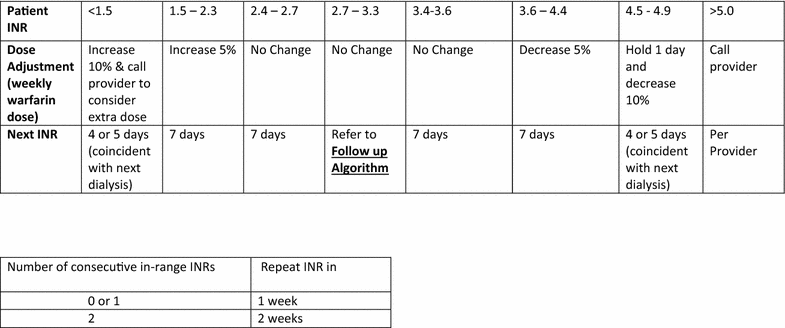A hemodialysis cohort study of protocol-based anticoagulation management
- PMID: 28126020
- PMCID: PMC5270310
- DOI: 10.1186/s13104-017-2381-7
A hemodialysis cohort study of protocol-based anticoagulation management
Abstract
Background: Chronic hemodialysis patients frequently require anticoagulation treatment with warfarin for a variety of co-morbidities. The optimal method for monitoring and dose adjustment of warfarin-based anticoagulation in this population, however, remains unclear. To examine this more closely, we reviewed all hemodialysis patients at a single institution on chronic warfarin therapy for a 10-month period prior to and after the institution of a standardized protocol for warfarin dose adjustment and monitoring. Anticoagulation efficacy was assessed by time within the therapeutic INR range (TTR), and resource utilization was assessed by the number of weekly INR measurements required for monitoring.
Results: We retrospectively analyzed 4481 patient-days of warfarin therapy data (from 25 hemodialysis patients) in the pre-protocol timeframe, and 3308 patient-days of warfarin therapy data (from 21 hemodialysis patients) in the on-protocol timeframe. Time within the therapeutic INR range (TTR) did not improve with institution of the dosing protocol-51.18% using non protocol-based management, and 51.57% using protocol-based management (p 0.73). However, overall resource utilization was reduced with institution of protocolized warfarin monitoring-from 1.71 INR measurements per patient-week pre-protocol, to 1.20 INR measurements per patient-week (p < 0.0001) post-protocol.
Conclusions: In this single-center study, institution of a standardized dosing protocol in a hemodialysis population on chronic warfarin therapy did not improve the rate of on-target anticoagulation, but did result in significantly lower resource utilization. We support protocol-based warfarin management in the hemodialysis population, but future work should examine the rate of on-target anticoagulation typically achieved in this group.
Keywords: Anticoagulation; Hemodialysis; Warfarin.
Figures
References
-
- Rosendaal F, Cannegieter S, van der Meer F, Briet E. A Method to determine the optimal intensity of oral anticoagulant therapy. Thromb Haemost. 1993;69(3):236–239. - PubMed
MeSH terms
Substances
LinkOut - more resources
Full Text Sources
Other Literature Sources
Medical
Research Materials
Miscellaneous



